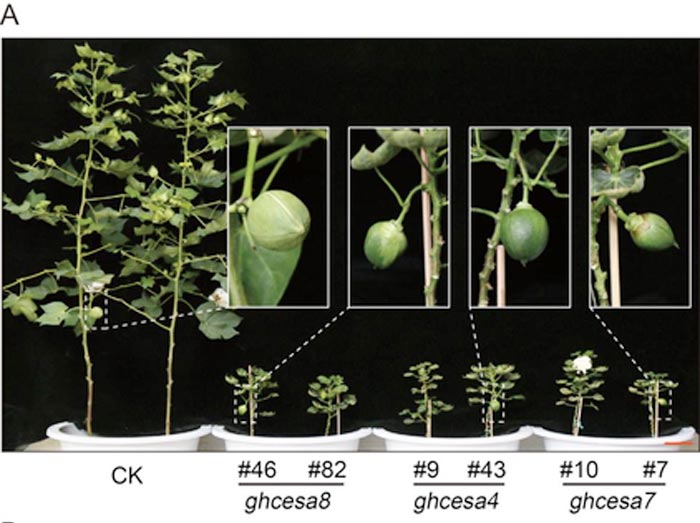Characterization of thirty-six-mer cellulose synthase supercomplex in cotton fiber

(A) Deletion mutations in GhCesA4, 7 and 8 gene resulted a in dramatic reduction of plant growth.
Credit: ©Science China Press
This study is led by Dr. Xingpeng Wen and Dr. Yuxian Zhu (Institute for Advanced Studies, Wuhan University).
About 180 billion tons of celluloses are produced by the world’s vegetation annually, making this polysaccharide the most abundant biological macromolecule on earth. It is produced predominantly by vascular plants, by a large number of algae and also by some bacteria, protists and tunicates. Cellulose microfibrils used for cell wall deposition are usually synthesized at the plasma membrane by the cellulose synthase complex (CSC) that is composed of at least three types of cellulose synthase required for glucan chain elongation synergistically.
The CSC produces glucan chains and the size of the CSC may determine the number of glucose chains in the microfibril structures, making them different in different organisms. However, no biochemical or molecular evidence has so far been available as to whether the number of cellulose synthase subunits in different CSC is related to the synthesis of cellulose microfibrils with various numbers of glucan chains in a bundle, a number which is key to the strength or tension of the secondary cell wall.

Credit: ©Science China Press
In this paper, Wen and Zhu report that in cotton (Gossypium hirsutum) fibers harvested at the secondary cell wall synthesis period, GhCesA4, 7 and 8 assembled heteromerizely into a previously uncharacterized 36 protein polymers like cellulose synthase supercomplex.
This super CSC was observed specifically in samples prepared using cotton fiber cells harvested during secondary cell wall period, but not from cotton stem tissue or any samples obtained from Arabidopsis. Knock-out experiments performed on any one of these three genes resulted in the disappearance of the CSC along with dramatic growth defects that reduced adult plant heights to less than a quarter of the wild-type. Cotton fibers harvested from these ghcesa-defective plants showed absolutely no secondary cell wall thickening. The CSC prepared from wild-type cotton fibers showed the highest enzyme activity with huge reduction found in samples prepared from Arabidopsis stems or from one of the three knock-out cotton mutants.
The team found that GhCesA4, 7 and 8 restored phenotypes of their orthologous Arabidopsis mutants, potentially by reforming the CSC hexamers. Genetic complementation was not observed when non-orthologous cellulose synthase genes were used for genetic transformation, indicating that each of the three subunits is indispensable for CSC formation and also for full cellulose synthase function.
They also reported the existence of four distinct types of cellulose microfibrils in different plant materials: the secondary cell wall of wild-type cotton fiber contains 72 glucan chains in a bundle, fiber cells from primary cell wall period and cesa-defective cotton mutants contain 36-glucan chains while mung bean hypocotyl and spruce stems contain 24 glucan chains, with all other samples including celery petiole, stem tissues of cotton or Arabidopsis are composed of 18 glucan chains.
In summary, the researchers experimentally confirmed, for the first time, the existence of 36-mer CSC during the cotton fiber secondary cell wall synthesis period. All three cellulose synthases were required for the formation of this 36-mer CSC, only homodimers were observed in mutant cotton lines with one of the GhCesA4, 7 or 8 genes knocked-out. They produced the world’s first mature cotton fiber cell with no secondary cell wall deposition and revealed that the cellulose microfibrils in cotton secondary cell wall were composed of 72 glucan chains. Cell-free membrane extract from cotton fiber were able to synthesize long chains of β-1,4-glucan with high enzyme activity in an in vitro system. Characterization of the cotton CSC together with its product will facilitate our understanding of mechanisms controlling secondary cell wall biosynthesis in different plant species.
See the article:
Molecular studies of cellulose synthase supercomplex from cotton fiber reveals its unique biochemical properties
http://engine.scichina.com/doi/10.1007/s11427-022-2083-9
Journal: Science China Life Sciences
DOI: 10.1007/s11427-022-2083-9
All latest news from the category: Life Sciences and Chemistry
Articles and reports from the Life Sciences and chemistry area deal with applied and basic research into modern biology, chemistry and human medicine.
Valuable information can be found on a range of life sciences fields including bacteriology, biochemistry, bionics, bioinformatics, biophysics, biotechnology, genetics, geobotany, human biology, marine biology, microbiology, molecular biology, cellular biology, zoology, bioinorganic chemistry, microchemistry and environmental chemistry.
Newest articles

Innovative 3D printed scaffolds offer new hope for bone healing
Researchers at the Institute for Bioengineering of Catalonia have developed novel 3D printed PLA-CaP scaffolds that promote blood vessel formation, ensuring better healing and regeneration of bone tissue. Bone is…

The surprising role of gut infection in Alzheimer’s disease
ASU- and Banner Alzheimer’s Institute-led study implicates link between a common virus and the disease, which travels from the gut to the brain and may be a target for antiviral…

Molecular gardening: New enzymes discovered for protein modification pruning
How deubiquitinases USP53 and USP54 cleave long polyubiquitin chains and how the former is linked to liver disease in children. Deubiquitinases (DUBs) are enzymes used by cells to trim protein…



